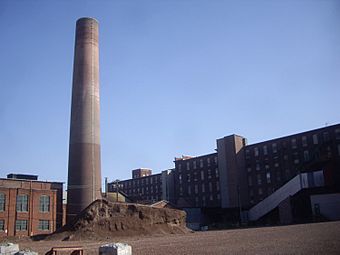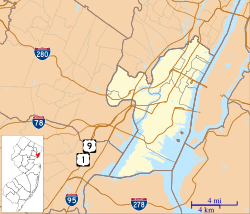Clark Thread Company Historic District facts for kids
|
Clark Thread Company Historic District
|
|
 |
|
| Location | 900 Passaic Avenue, East Newark, New Jersey, USA |
|---|---|
| Area | 13 acres (5.3 ha) |
| Built | 1875 |
| NRHP reference No. | 78001764 |
Quick facts for kids Significant dates |
|
| Added to NRHP | June 2, 1978 |
| Designated NHLD | June 2, 1978 |
The Clark Thread Company Historic District is a really old factory area in East Newark, New Jersey. It's located at 900 Passaic Avenue in Hudson County, New Jersey. This big group of buildings was once a super important place where the Clark Thread Company made sewing thread. From 1875 until 1935, Clark Thread Company was the biggest thread maker in the world! Because of its important history, this whole area was named a National Historic Landmark in 1978. Today, it's an industrial park, which means lots of different businesses use the old factory buildings.
What is the Clark Thread Company Historic District?
This historic district is located in East Newark, right next to the Passaic River. It covers about 13 acres (that's like 10 football fields!). The area is bordered by Passaic, Grant, and Central Avenues. There's also a railroad track nearby.
There are 35 buildings in the district. They were all built between 1875 and 1910. Most of them are made of brick. The biggest buildings are four stories tall. They have many rows of windows with rounded tops.
A Brief History of the Clark Thread Company
The Clark Company was started in 1864. It was founded by two brothers, George and William Clark. Their father, James Clark, was a thread maker in Scotland. The brothers first set up their business in Newark, New Jersey.
In 1875, the Clark Company moved and grew into the East Newark area. They became very famous for their special thread. This thread was made to work perfectly with the new sewing machines that were becoming popular.
By 1873, the Clark Company was the largest thread maker in the United States! The company kept growing. In 1897, after William Clark passed away, the company joined with another big thread maker called J&P Coats.
Coats and its other companies kept making thread at this location. But in the 1930s, they started moving their factories to the southern United States. Now, the old factory buildings are used by many different types of businesses.




